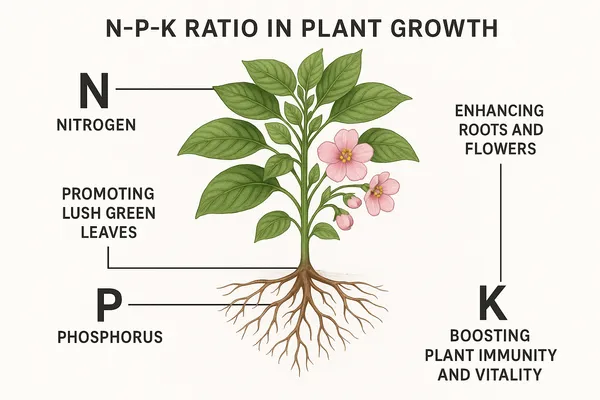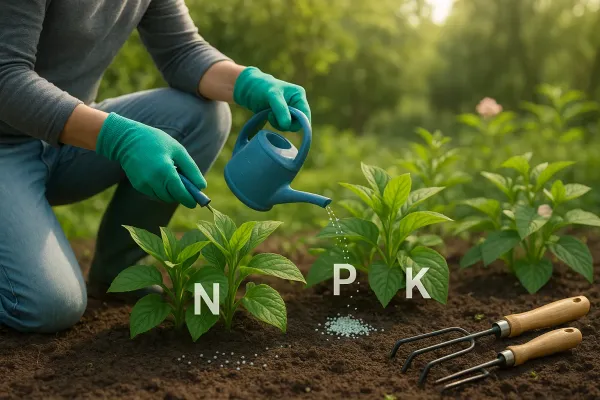Avoid your inquiry is delay response, please enter your WhatsApp/Skype along with the message, so we can contact you at the very first time.
We will reply you within 24 hours. If for urgent case, please add WhatsApp/WeChat:
Warning: Undefined variable $public in /www/wwwroot/lvfertilizer.com/wp-content/themes/hyhadmin/header.php on line 350
Warning: Trying to access array offset on value of type null in /www/wwwroot/lvfertilizer.com/wp-content/themes/hyhadmin/header.php on line 350
,. Or call
Warning: Undefined variable $public in /www/wwwroot/lvfertilizer.com/wp-content/themes/hyhadmin/header.php on line 350
Warning: Trying to access array offset on value of type null in /www/wwwroot/lvfertilizer.com/wp-content/themes/hyhadmin/header.php on line 350
directly.
Many growers struggle to find the ideal N-P-K Ratio for their fields or gardens, but they also worry about nutrient deficiency, soil fertility challenges, and wasted money on massive trial-and-error attempts at fertilizer formulations. They feel uncertain about macronutrient ratio requirements and the best way to tackle varied soil testing results . Some see references to balanced fertilizer (like 10-10-10) everywhere, but these one-size-fits-all blends often do not address specific crop-specific NPK needs . Without clear knowledge, many resort to repeated guesswork.
This confusion leads to anxious moments. Plants may suffer from nitrogen deficiency, phosphorus deficiency, or potassium deficiency . Crops may show stunted root development §, weak vegetative growth (N), or poor flowering/fruiting (P/K) . Growers invest in high-nitrogen fertilizer or high-phosphorus fertilizer without understanding fertilizer composition or nutrient uptake . Overuse of synthetic fertilizer NPK can cause fertilizer burn, nutrient leaching, and harmful environmental impacts . Under-application, on the other hand, leads to yields dropping by up to 30% . Such confusion also extends to water-soluble fertilizer choices, controlled-release fertilizer timing, and the subtle differences between organic fertilizer NPK and synthetic fertilizer NPK . Some get lost comparing starter fertilizer, blended fertilizer, or even specialized products like ammonium sulphate (nitrogen fertilizer). Meanwhile, crop-specific NPK demands remain unmet .
There is a clear path to nutrient balance. Here, we explore proven methods for determining the ideal NPK ratio, share real-world data, and show how a specialized approach can address your needs. For urgent questions on n-p-k ratio, remember that there is no single magic formula. Each farmland or garden is unique . But with advanced technology and specialized guidance, you can find the right path.
1.1 Why Plants Depend on the N-P-K Ratio
Plants rely on nitrogen (N), phosphorus §, and potassium (K) for different growth stages . Nitrogen (N) fuels leafy growth. Phosphorus § powers root and blossom development. Potassium (K) aids disease resistance and overall vitality . In industry terms, it is called N-P-K Ratio or macronutrient ratio .
So, the macronutrient ratio you see on product labels—like 10-10-10 or 20-20-20—shows the relative percentage of N, P, and K .

1.2 Key Setting: Soil Testing
A soil test report is essential to confirm what nutrients your soil already contains . Some soils are high in potassium but short on nitrogen. Others might need more phosphorus sources . This information helps you pick the right fertilizer formulation .
1.3 Tailoring Ratios for Best Results
A single balanced fertilizer (such as 10-10-10) is not always best . For example, high-phosphorus fertilizer (like 5-10-5) supports heavy blooms in flowers, while high-nitrogen fertilizer (such as 20-5-5) can boost lawns . The ratio must match crop stage and soil conditions .
Below is data gleaned from field studies and research across different crops and soils:
Table 1: Crop-Specific NPK Optimization
| Crop | Optimal NPK Ratio | Yield Increase | Research Findings |
| Rice (Paddy) | 4:2:1 | 28-32% | 150:75:37.5 kg/ha outperformed controls in West Bengal . |
| Tomatoes | 1:3:1 | ~23% fruit yield | High-P ratio (like 5-10-5) boosted fruit set, reduced fruit drop . |
| Turfgrass | 4:1:2 | 19% growth | 20-5-10 ratio improved drought endurance (Penn State Ext.) . |
| Wheat | 3:1:1 | 21-26% | NPK prescriptions lowered fertilizer waste by 34% . |
Table 2: Soil-Tailored NPK Recommendations
| Soil Condition | Ideal Ratio | Impact |
| Low Phosphorus § | 1:2:1 | 45% correction of P deficiency, 30% root mass gain |
| Sandy Soils (High Leaching) | 1:1:2 | Reduced N leaching by 52%, improved K retention |
| Acidic Soils (pH<6) | 1:4:1 | P availability up by 62% due to reduced Al fixation |
These findings show how crop-specific NPK and soil fertility tie together .
1
Precision Matters: Site-specific NPK reduced waste by 34%
2
Soil Testing Critical: Accounts for 45% P-deficiency correction
3
Phosphorus Crucial: Boosts fruit yield by 23% in tomatoes
Excess applications produce fertilizer burn and nutrient leaching . This not only damages plants but also leads to pollution .
Lack of nutrients triggers plant stress and yield loss . Fields remain deficient in nitrogen, phosphorus, or potassium, compromising final crop quality .
Starter fertilizer suits early root establishment, while bloom booster helps flowering. Failing to customize leads to suboptimal growth .
Runoff from synthetic fertilizer NPK can harm water habitats. Balanced application timing, plus mindful usage of organic fertilizer NPK, fosters fertilizer sustainability .
Perform a soil test report to check pH, organic matter content, and baseline micro- and macronutrient levels .
Identify main soil problems (e.g., phosphorus deficiency) and match the ratio to your crop’s growth stage .
(Interested in customizable blends? See our compound fertilizer page for more info.)
Plants signal nutrient needs. Watch for nutrient deficiency markers: poor growth, leaf discoloration, or minimal yields . Adjust your fertilizer formulations accordingly.
(For water-soluble solutions, see water soluble fertilizer for a wide variety of high-quality blends.)

Data indicate that matching fertilizer composition to the precise macronutrient ratio can yield 30% more produce . For example, using a site-specific 10-5-20 formula on fruit trees led to a 23% yield gain in some trials . Meanwhile, balanced application improved root development § by 30% in low-P soils, boosting ultimate harvest quality.
Case Study:
Those figures underscore how mindful use of complete fertilizer or incomplete fertilizer can transform outcomes .
We incorporate advanced science into each product to ensure nutrient uptake efficiency and minimal nutrient leaching .
(Looking to learn more about specialized blends? Explore our npk plant fertilizer range for a variety of ratio options.)
You are uncertain about the best N-P-K Ratio. You risk stunted plants, wasted time, and unpredictable harvests . This can hamper financial stability.
The confusion grows if you have acidic soils (pH<6) or sandy soils. Over-application can trigger fertilizer burn or pollute water. Meanwhile, ignoring soil fertility or a needed high-potassium fertilizer leads to sickly fields .
Start with a soil test report. Balance your macronutrient ratio based on your soil fertility and crop-specific NPK demands. Seek specialized help from Shandong Lvfeng Fertilizer Co., Ltd., which has 26+ years of success blending N-P-K Ratio for global clients.
We employ nutrient use efficiency measures, micronutrients, and advanced fertilizer placement strategies. Our water-soluble fertilizers, compound fertilizers, and trace element blends target each nutrient requirement in your soil . This approach cuts guesswork and ensures strong yields.
For more solutions, check out the ideal npk ratio resources on our website.

Reduced Impact: Our products aim to reduce nutrient leaching by adhering to recommended fertilizer application rate and focusing on controlled release.
Higher Efficiency: Soil-test-based nutrient management means less run-off. That helps preserve river habitats, making it a fertilizer sustainability approach.
A melon grower in Southeastern Asia discovered that fruit set was weak. They had used only 10-10-10 for years. Our specialists performed soil analysis (pH, organic matter content, base dressing levels). The test revealed a phosphorus shortage.
We created a 12-36-12 formula, using NPK 12-36-12 Water Soluble Fertilizer, to boost early root development . The grower then switched to 15-15-30 for the fruiting stage. Yields rose 25%, and overall fruit quality improved . This example demonstrates how blended fertilizer with proper fertilizer placement can solve nutrient deficiency for real results.
Precision agriculture is taking root. Innovations in sensor-driven soil testing, fertigation NPK, and hydroponic NPK can further refine nutrient balance. Farmers who adopt these methods, combined with the right fertilizer composition, see substantial yield gains.
Recap: The ideal N-P-K Ratio depends on your crop’s needs, soil chemistry, and growth stages. A universal formula does not exist. Instead, rely on soil testing to identify deficiencies, then pick from balanced fertilizer or specialized formulations such as high-nitrogen fertilizer, high-phosphorus fertilizer, or high-potassium fertilizer.
Shandong Lvfeng Fertilizer Co., Ltd. has spent 26+ years passionately refining fertilizer formulations, blending advanced technology with the wisdom of agronomic efficiency. We employ rigorous fertilizer analysis, calibrating each product to meet your nutrient requirements With our custom fertilizer blends, you gain time-tested solutions for ammonium sulphate (nitrogen fertilizer), water-soluble fertilizer, or even compound fertilizer (NPK, binary, BB). Our integrated approach fosters high yields, healthy soils, and satisfied growers around the world.
We also maintain strong ties to leading agricultural institutes, ensuring our fertilizer efficacy aligns with global best practices. Our ISO 9001 certification further cements our commitment to quality and reliability .
In short, focus on your soil, your crop, and your environment. Add specialized guidance from industry experts. Then watch your yields increase. For more insights, see our npk fertilizer supplier page and find solutions that may fit your exact needs.
Final Thought: Optimize your N-P-K Ratio with science, strategy, and skill. Shandong Lvfeng Fertilizer Co., Ltd. stands ready to help turn that plan into prosperous harvests. By tackling the fundamental problem of nutrient imbalance, exploring the agitation of potential crop damage, and embracing a solution grounded in data, you can protect your livelihood and ensure a brighter future for agriculture worldwide.